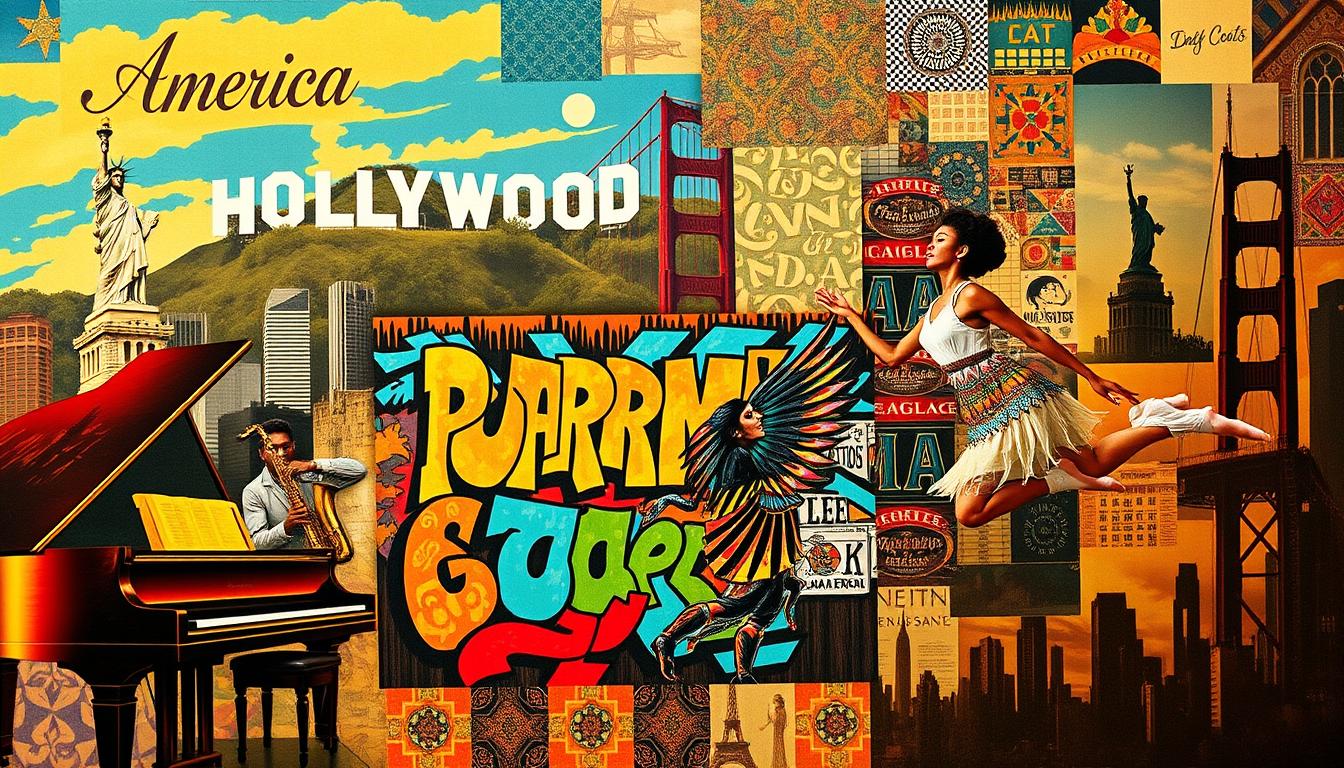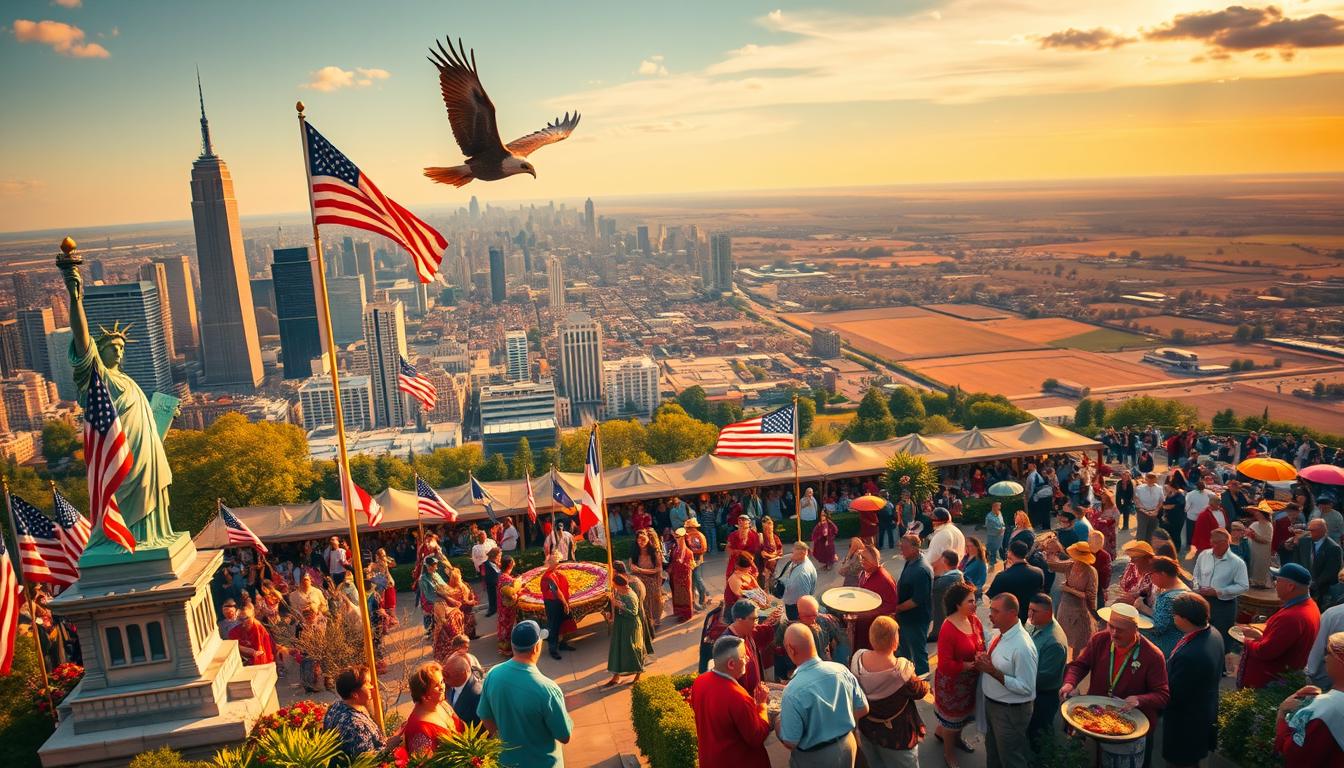The United States is a melting pot of diverse cultural heritage, shaped by the influences of its indigenous people, immigrants, and historical events.
The country’s American identity is a rich tapestry of customs, beliefs, and values that have evolved over time, reflecting the nation’s growth and diversity.
From the jazz clubs of New Orleans to the Native American reservations, the United States is home to a wide range of cultural expressions that are worth exploring.
Key Takeaways
- The United States has a diverse cultural heritage shaped by its history and people.
- American identity is reflected in its customs, beliefs, and values.
- The country’s cultural landscape is characterized by its indigenous people and immigrant communities.
- Cultural traditions in the United States are varied and widespread.
- Exploring these traditions can provide a deeper understanding of American society.
The American Cultural Mosaic: A Nation of Diversity
The United States is often described as a melting pot, but a more accurate metaphor might be a mosaic, where diverse cultures blend together while maintaining their unique characteristics. This cultural mosaic is the result of centuries of immigration, which has shaped the nation’s identity.
Historical Immigration Waves and Their Cultural Impact
The history of immigration in the United States is marked by significant waves that have contributed to its cultural diversity. One of the most pivotal moments was the Great Migration through Ellis Island.
Ellis Island and the Great Migration
Between 1892 and 1954, over 12 million immigrants passed through Ellis Island on their way to a new life in America. This period saw a massive influx of people from Southern and Eastern Europe, contributing to the cultural and demographic shifts in the United States.
“Ellis Island was not just a gateway; it was a threshold to a new world, filled with promise and possibility.”
20th Century Immigration Patterns
The 20th century saw further changes in immigration patterns, with increased migration from Asia and Latin America. These new waves brought with them diverse cultures, languages, and traditions, further enriching the American mosaic.
The Concept of E Pluribus Unum in American Identity
The motto “E Pluribus Unum” (Out of many, one) reflects the ideal of unity in diversity. It symbolizes the American aspiration to integrate diverse cultures into a cohesive national identity while preserving individual cultural heritage.
| Immigration Wave | Primary Regions of Origin | Cultural Contributions |
|---|---|---|
| Ellis Island Era | Southern and Eastern Europe | Culinary traditions, cultural festivals |
| 20th Century | Asia, Latin America | New musical genres, diverse culinary influences |
The American cultural mosaic is a testament to the nation’s ability to integrate diverse cultures into a vibrant national identity. As the United States continues to evolve, its cultural diversity remains a cornerstone of its strength and resilience.
Native American Cultural Traditions and Their Living Legacy
For centuries, Native American tribes have preserved their unique cultural traditions, contributing significantly to the mosaic of American culture. The diverse heritage of these communities is a testament to their resilience and the richness of their cultural practices.
Tribal Diversity and Regional Differences
Native American cultural traditions vary greatly across different tribes and regions. This diversity is reflected in their customs, languages, and art forms.
Pueblo Traditions of the Southwest
The Pueblo tribes of the Southwest are known for their sophisticated irrigation systems and multi-story dwellings. Their cultural practices include vibrant ceremonial dances and intricate pottery.
Woodland Tribal Customs of the East
Woodland tribes, such as the Iroquois, have a rich tradition of storytelling, basket weaving, and ceremonial rituals. Their cultural practices are deeply connected to the natural environment.
Contemporary Preservation Efforts
Efforts to preserve Native American cultural traditions include language documentation, cultural education programs, and the preservation of historical sites. These initiatives are crucial for maintaining the cultural heritage of Native American communities.
Influence on Modern American Identity
Native American cultural traditions have significantly influenced modern American identity. From art and literature to environmental conservation, the legacy of Native American cultures continues to shape American society.
| Cultural Practice | Description | Region |
|---|---|---|
| Ceremonial Dances | Vibrant dances performed during ceremonies | Southwest |
| Basket Weaving | Intricate weaving of baskets for practical and ceremonial use | East |
| Pottery | Crafting of pottery for both functional and decorative purposes | Southwest |
The legacy of Native American cultural traditions is a vital part of America’s cultural heritage, enriching the lives of both Native American communities and the broader American public.
Exploring Regional Cultural Traditions Across America
From the Southern hospitality to the Western frontier spirit, each region in the U.S. boasts its unique cultural heritage. The diverse cultural traditions across America are shaped by historical immigration patterns, geographical characteristics, and the blending of different ethnic influences.
Southern Traditions and Hospitality
The Southern United States is renowned for its warm hospitality and rich cultural heritage. The region’s history, from the antebellum era to the Civil Rights Movement, has significantly influenced its traditions.
Cajun and Creole Heritage
In Louisiana, the Cajun and Creole cultures have blended French, Spanish, African, and Native American influences, creating a unique cultural identity. This is reflected in their cuisine, music, and festivals like Mardi Gras.
Appalachian Folk Customs
The Appalachian region has a distinct folk culture, with roots in Scottish, Irish, and English traditions. Storytelling, bluegrass music, and handmade crafts are integral to Appalachian heritage.
Northeastern Cultural Heritage
The Northeast, with its colonial history and significant immigration from Europe, has a rich cultural landscape. Cities like Boston and New York are hubs for cultural institutions, museums, and diverse culinary traditions.
Midwestern Values and Customs
The Midwest is often characterized by its down-to-earth values, friendly communities, and agricultural heritage. The region hosts numerous county fairs and festivals celebrating its farming traditions.
Western Frontier Spirit and Traditions
The Western United States is associated with the pioneering spirit and a culture of independence. Rodeos, cowboy culture, and the influence of Native American and Mexican cultures are prominent in this region.
These regional cultural traditions not only enrich the fabric of American society but also contribute to the country’s diverse identity. Understanding and appreciating these differences can foster a greater sense of unity and shared cultural heritage across the nation.
American Holiday Celebrations and Festivities
American holiday festivities are a vibrant tapestry of traditions, shaped by the nation’s history and cultural diversity. These celebrations not only bring people together but also serve as a reflection of the country’s values and heritage.

National Holidays and Their Cultural Significance
National holidays play a crucial role in American culture, often commemorating significant historical events or values. Two of the most notable national holidays are Thanksgiving and Independence Day.
Thanksgiving: America’s Family Gathering
Thanksgiving is celebrated on the fourth Thursday of November every year. It’s a time when families come together, sharing a meal and expressing gratitude for their blessings. The tradition dates back to the early European settlers and has since evolved into a quintessential American holiday.
Independence Day Celebrations
Independence Day, celebrated on July 4th, marks the adoption of the Declaration of Independence in 1776. It’s a day of patriotic fervor, with parades, fireworks, and family gatherings across the nation. This holiday symbolizes American independence and freedom.
Regional and Local Celebrations
Apart from national holidays, the United States is home to a variety of regional and local celebrations. These events often reflect the unique cultural, historical, or geographical characteristics of a particular area. For instance, Mardi Gras in New Orleans and the Albuquerque International Balloon Fiesta are examples of regional festivities that attract visitors from around the world.
Evolution of Holiday Traditions Over Time
Holiday traditions in America are not static; they evolve over time, influenced by cultural shifts, technological advancements, and societal changes. For example, the way people celebrate Thanksgiving has changed with the advent of new technologies, allowing for virtual gatherings and the sharing of experiences through social media.
In conclusion, American holiday celebrations are a dynamic and integral part of the country’s cultural identity. They reflect the nation’s history, diversity, and values, bringing people together in a spirit of unity and festivity.
The Rich Tapestry of American Food Traditions
From coast to coast, American cuisine is a vibrant tapestry woven with threads of different cultures. The diverse culinary landscape of the United States is a reflection of its rich history, geographical vastness, and the myriad cultures that have shaped the nation.
Regional Cuisine and Food Heritage
American food traditions vary significantly across different regions, each with its unique flavor profiles and cooking techniques. The country’s regional cuisine is a testament to its cultural diversity.
Soul Food and Southern Cooking
Soul food, deeply rooted in African American culture, is characterized by its rich flavors and hearty dishes such as fried chicken, collard greens, and cornbread. Southern cooking, known for its hospitality, often features comfort foods that bring people together.
New England Seafood Traditions
New England’s culinary identity is heavily influenced by its coastal location, with seafood being a staple. Fresh lobster, clam chowder, and fish dishes are emblematic of the region’s cuisine, reflecting its maritime heritage.
Immigrant Influences on American Food
The history of American cuisine is also a story of immigration. Various immigrant groups have introduced new ingredients, cooking methods, and dishes that have been assimilated into the American culinary fabric.
For instance, Italian immigrants introduced pasta dishes and pizza, which have become staples in American food culture. Similarly, Mexican immigrants have influenced the popularity of tacos and other Mexican cuisine across the United States.
“Food is the ingredient that binds us together.” – Unknown
Food Festivals and Culinary Celebrations
Food festivals are an integral part of American cultural celebrations, showcasing local ingredients, culinary traditions, and community spirit. Events like the New Orleans Jazz & Heritage Festival and the Maine Lobster Festival attract visitors from across the country, celebrating the rich diversity of American food.
- The annual Thanksgiving dinner is a quintessential American tradition, symbolizing gratitude and family bonding.
- Food trucks have become increasingly popular, offering a wide range of cuisines from gourmet burgers to Korean BBQ.
American food traditions are a dynamic and evolving aspect of the country’s culture, influenced by its history, geography, and diverse population. As American cuisine continues to evolve, it remains a vibrant reflection of the nation’s identity.
Vibrant Cultural Traditions in American Music and Arts
From jazz to visual arts, America’s cultural landscape is dotted with diverse traditions that tell the story of its people. The country’s rich cultural heritage is reflected in its music, arts, and performance traditions, shaped by historical influences and multicultural identities.
The Birth and Evolution of American Music Genres
American music genres have a fascinating history, with roots in various cultural traditions. Jazz and blues are two genres that originated in the African-American communities of the Deep South.
Jazz, Blues, and Their Cultural Roots
Jazz and blues have been instrumental in shaping American music. Emerging in the early 20th century, jazz was characterized by its improvisational style and blend of African and European music traditions. Blues music, with its soulful melodies and storytelling, expressed the hardships and emotions of African-American life.
| Genre | Origin | Characteristics |
|---|---|---|
| Jazz | African-American communities | Improvisation, blend of traditions |
| Blues | Deep South | Soulful melodies, storytelling |
Country, Folk, and Regional Music Traditions
Country and folk music have their roots in European and Appalachian traditions. These genres have evolved over time, incorporating various regional influences and storytelling elements.
Visual Arts and Craftsmanship Traditions
American visual arts are a vibrant reflection of the country’s diverse cultural heritage. From Native American pottery to contemporary art movements, the U.S. has a rich tradition of craftsmanship and artistic expression.

Performance Arts and Theater Heritage
The United States has a thriving tradition of performance arts and theater. From Broadway shows to regional theater productions, American theater is known for its diversity and creativity.
By embracing its diverse cultural traditions, the U.S. continues to evolve as a melting pot of artistic expression, reflecting the country’s history, identity, and creativity.
Religious and Spiritual Cultural Traditions
From coast to coast, the U.S. is home to a vibrant tapestry of religious and spiritual cultural traditions. This diversity is a cornerstone of American identity, reflecting the country’s history of immigration and the pursuit of religious freedom.
Diversity of Faith Practices in America
The United States is characterized by a broad spectrum of faith practices. Christian denominational traditions are among the most prevalent, with numerous denominations such as Baptist, Methodist, and Catholic communities.
Christian Denominational Traditions
Christian denominations in the U.S. have a rich history, with each contributing uniquely to American cultural heritage. For instance, the Baptist community has played a significant role in social justice movements, while Catholic communities have contributed to education and healthcare.
Non-Christian Religious Communities
In addition to Christian traditions, the U.S. is home to thriving non-Christian religious communities, including Jewish, Muslim, Hindu, and Buddhist populations. These communities have enriched American culture through their religious practices, festivals, and cultural events.
Religious Holidays and Observances
Religious holidays are an integral part of American cultural life. Christmas and Easter are widely observed, while other religious communities celebrate their own significant holidays such as Hanukkah, Eid al-Fitr, and Diwali. These observances often blend religious and cultural practices, contributing to the rich tapestry of American traditions.
“The diversity of religious traditions in America is a strength, not a weakness. It enriches our culture, broadens our perspectives, and reminds us of the importance of tolerance and understanding.”
Spiritual Traditions Beyond Organized Religion
Beyond organized religious practices, many Americans engage in spiritual traditions that are not necessarily tied to a specific faith community. These practices, including meditation and mindfulness, reflect a broader interest in spirituality and personal growth.
The diverse religious and spiritual cultural traditions in the United States not only reflect the country’s pluralistic society but also contribute to its cultural richness and identity.
Experiencing America’s Cultural Traditions as a Visitor
Visitors to the United States can immerse themselves in a rich tapestry of cultural traditions. The country’s diverse cultural heritage is reflected in its numerous cultural heritage sites, museums, festivals, and events open to the public.
Cultural Heritage Sites and Museums
America is home to a plethora of cultural heritage sites and museums that showcase its rich history and cultural diversity. The Smithsonian Institution in Washington, D.C., for example, is a collection of museums and research centers that offer a deep dive into various aspects of American culture and history. Visitors can explore exhibits on everything from the Native American experience to the history of American music.
Festivals and Events Open to the Public
The United States is renowned for its vibrant festivals and events that celebrate its cultural heritage. These events range from national celebrations to local festivities, offering something for everyone.
State Fairs and Their Cultural Significance
State fairs are a quintessential American experience, showcasing local agriculture, music, and cuisine. The Iowa State Fair, for instance, is famous for its “Butter Cow” sculpture and offers a taste of Midwestern hospitality.
Cultural Heritage Festivals
Cultural heritage festivals are another way to experience America’s diverse cultural landscape. The National Cherry Blossom Festival in Washington, D.C., celebrates the gift of cherry blossom trees from Japan, symbolizing the friendship between the two countries.
Immersive Cultural Experiences
For a more immersive experience, visitors can participate in cultural workshops, cooking classes, or attend performances that showcase traditional music and dance.
“The cultural heritage of America is not just about the past; it’s a living, breathing entity that continues to evolve and enrich our lives today.”
By engaging with these cultural experiences, visitors can gain a deeper understanding and appreciation of America’s rich cultural heritage.
Conclusion: Embracing and Preserving America’s Cultural Heritage
The United States is a vibrant tapestry of diverse cultural traditions, woven together by the threads of history, immigration, and regional identity. From the rich Native American heritage to the influences of European, African, and Asian immigrants, American cultural heritage is a complex and fascinating mosaic.
Preservation efforts are crucial to maintaining this cultural heritage for future generations. Cultural heritage sites, museums, and festivals play a significant role in celebrating and preserving the traditions that make America unique. By embracing and preserving these cultural traditions, we can continue to foster a strong sense of American identity.
As the nation continues to evolve, it is essential to recognize the importance of cultural heritage in shaping American society. By supporting preservation efforts and celebrating the diverse cultural traditions that make up the fabric of American identity, we can ensure that this rich heritage continues to thrive.
FAQ
What are the main cultural traditions in the United States?
The United States is a melting pot of cultures, with influences from Native American, European, African, and Asian traditions, among others. Some of the main cultural traditions include Southern hospitality, New England seafood traditions, and the vibrant music heritage of jazz and blues.
How have immigration waves shaped American cultural identity?
Immigration waves have significantly contributed to the cultural diversity of the United States. The Great Migration through Ellis Island and 20th-century immigration patterns have brought various cultural practices, traditions, and values that have blended with existing American culture.
What is the significance of Native American cultural traditions?
Native American cultural traditions are a vital part of American heritage, with diverse tribal customs and regional differences. Pueblo traditions in the Southwest and Woodland tribal customs in the East are examples of the rich cultural legacy of Native American communities.
How do regional cultural traditions vary across America?
Regional cultural traditions vary significantly across the United States, reflecting the unique history, geography, and cultural influences of each area. For example, the South is known for its hospitality, while the Northeast is famous for its seafood traditions.
What are some of the most important American holiday celebrations?
Thanksgiving and Independence Day are two of the most significant national holidays in the United States, with cultural and historical significance. Regional and local celebrations, such as Mardi Gras and the Albuquerque International Balloon Fiesta, also showcase the country’s diverse cultural heritage.
How has American food been influenced by immigrant cultures?
American food has been shaped by various immigrant cultures, including Italian, Mexican, Chinese, and Indian cuisines, among others. The blending of culinary traditions has resulted in the creation of new dishes and flavors that are distinctly American.
What are some ways to experience America’s cultural traditions as a visitor?
Visitors can experience America’s cultural traditions by visiting cultural heritage sites, museums, and attending festivals and events open to the public. State fairs, cultural heritage festivals, and immersive cultural experiences, such as cooking classes or traditional craft workshops, offer a deeper understanding of American culture.
How can we preserve America’s cultural heritage for future generations?
Preserving America’s cultural heritage requires continued celebration and preservation of cultural traditions. This can be achieved through education, cultural events, and the protection of cultural heritage sites and artifacts.



